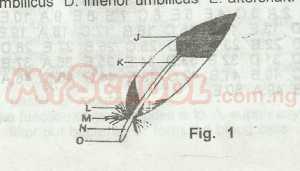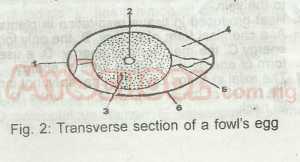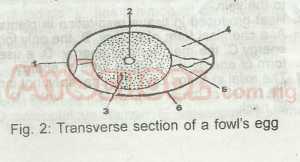Year :
1984
Title :
Biology
Exam :
JAMB Exam
Paper 1 | Objectives
41 - 50 of 50 Questions
| # | Question | Ans |
|---|---|---|
| 41. |
Which of the following groups of factors is completely abiotic? A. Salinity, tide, plankton, turbidity B. Temperaure, pH, soil, insect C. Wind, altitude, humidity, light D. Conifers, wind, pH, rainfall E. Soil, water, bacteria, salinity |
C |
| 42. |
Which of the following lists of diseases, their causes and transmission is CORRECT? A. Cholera, virus, severe diarrhoea, infected water B. Malaria, protozoan, high fever, contact with infected person C. Syphilis, virus, veneral disease, sexual intercourse D. small pox, virus, skin with blister, close contact with infected person E. Sleeping sickness, bacteria, tiredness, headache and dozing, tsetsefly bite |
D |
| 43. |
Erosion can be reduced along shape by A. ridging across slope B. ridging up slope C. ridging down slope D. crop rotation E. bush fallowing system |
A |
| 44. |
If a handful of soil is shaken with water and left to settle, the soil particles will settle from light to heavy particles as follows A. humus, clay, silt, sand, stones B. humus, silt, clay, sand, stones C. humus, clay,silt, stones, sand D. humus, sand, silt, clay, stones E. clay, humus, silt, sand, stones |
A |
| 45. |
Denitrifying bacteria in nature liberate gaseous nitrogen directly from A. ammonium salts B. soil nitrates C. thunderstorms D. soil nitrites E. plant and animal proteins |
B |
| 46. |
Leaching is A. Washing away of humus from the soil surface B. reducing of soil aeration by pressure C. soil erosion by means other than rainfall D. loss of organic matter due to exposure to direct sunlight E. washing out chalk and limestone from upper layers of by heavy rains |
A |
| 47. |
The process of soil erosion is usually from A. rill → sheet → gully B. gully → rill → sheet C. sheet → guly → rill D. sheet → rill → gully E. rill → gully → sheet |
D |
| 48. |
 The structure above represents a quill feather. The structure labelled 'M' is the A. quill B. rachis C. superior umbilicus D. inferior umbilicus E. aftershaft |
C |
| 49. |
 The young chick is formed from A. 3 B. 3 and 4 C. 1, 3 and 5 D. 2 E. 4 |
D |
| 50. |
 Which parts provide food for the developing chick? A. 2 and 3 B. 4 and 5 C. 3 and 4 D. 2 and 5 E. 1 and 2 |
C |
| 41. |
Which of the following groups of factors is completely abiotic? A. Salinity, tide, plankton, turbidity B. Temperaure, pH, soil, insect C. Wind, altitude, humidity, light D. Conifers, wind, pH, rainfall E. Soil, water, bacteria, salinity |
C |
| 42. |
Which of the following lists of diseases, their causes and transmission is CORRECT? A. Cholera, virus, severe diarrhoea, infected water B. Malaria, protozoan, high fever, contact with infected person C. Syphilis, virus, veneral disease, sexual intercourse D. small pox, virus, skin with blister, close contact with infected person E. Sleeping sickness, bacteria, tiredness, headache and dozing, tsetsefly bite |
D |
| 43. |
Erosion can be reduced along shape by A. ridging across slope B. ridging up slope C. ridging down slope D. crop rotation E. bush fallowing system |
A |
| 44. |
If a handful of soil is shaken with water and left to settle, the soil particles will settle from light to heavy particles as follows A. humus, clay, silt, sand, stones B. humus, silt, clay, sand, stones C. humus, clay,silt, stones, sand D. humus, sand, silt, clay, stones E. clay, humus, silt, sand, stones |
A |
| 45. |
Denitrifying bacteria in nature liberate gaseous nitrogen directly from A. ammonium salts B. soil nitrates C. thunderstorms D. soil nitrites E. plant and animal proteins |
B |
| 46. |
Leaching is A. Washing away of humus from the soil surface B. reducing of soil aeration by pressure C. soil erosion by means other than rainfall D. loss of organic matter due to exposure to direct sunlight E. washing out chalk and limestone from upper layers of by heavy rains |
A |
| 47. |
The process of soil erosion is usually from A. rill → sheet → gully B. gully → rill → sheet C. sheet → guly → rill D. sheet → rill → gully E. rill → gully → sheet |
D |
| 48. |
 The structure above represents a quill feather. The structure labelled 'M' is the A. quill B. rachis C. superior umbilicus D. inferior umbilicus E. aftershaft |
C |
| 49. |
 The young chick is formed from A. 3 B. 3 and 4 C. 1, 3 and 5 D. 2 E. 4 |
D |
| 50. |
 Which parts provide food for the developing chick? A. 2 and 3 B. 4 and 5 C. 3 and 4 D. 2 and 5 E. 1 and 2 |
C |